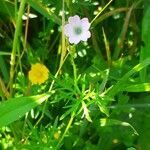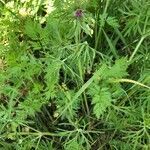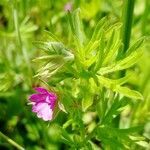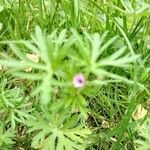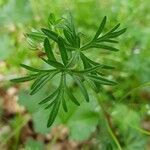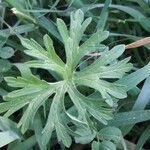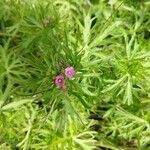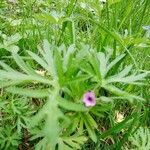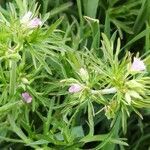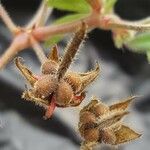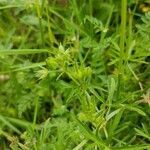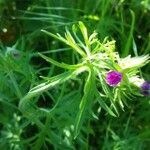Annual herb, stems up to ±60 cm long, erect or ascending, thinly pilose with retrorse eglandular hairs. Stipules ovate, acuminate. Radical leaves tufted, petioles up to ±150 mm long, pilose as the stems; blade up to ±50 mm in diam., deeply 5-7-lobed, each lobe cuneate in outline, deeply dissected, glabrous or sparsely hairy above, more densely so below particularly on the veins; cauline leaves similar but petioles rapidly shorter. Peduncles opposite the leaves and shorter than they, usually 2-flowered, pilose with spreading or somewhat retrorse hairs. Pedicels pilose with spreading hairs, some gland-tipped. Sepals ±4 x 2 mm, glandular-pilose. Petals ±5 x 2 mm, obovate, notched, purplish-pink. Rostrum glandular-pilose. Carpels smooth, hairy.
Annual herb, 0.1-0.6 m long; erect or ascending; scarcely pilose with retrorse, eglandular hairs. Radical leaves tufted; lamina up to 50 mm in diam., deeply 5-7-lobed, each lobe cuneate in outline, deeply dissected; glabrous to sparsely hairy above, denser below; petioles up to 150 mm long; cauline leaves similar, petioles rapidly shorter. Inflorescences opposite leaves, usually 2-flowered; peduncles shorter than upper leaves; pilose with spreading or somewhat retrorse hairs; pedicels hairy as for stems, additionally gland-tipped. Sepals 4 x 2 mm, glandular-pilose. Petals 5 x 2 mm, obovate, notched, purplish pink. Flowering time Oct.-Dec. Carpels smooth and hairy.
An annual herb plant. It grows 50 cm high. The stems have some hairs. The leaves at the base are in a ring. They are 3-5 cm long and 3.5-9 cm wide. The leaves are divided like fingers on a hand. The lobes are also divided. The lower leaves have longer stalks than the upper leaves. The flowers are usually in pairs. The stalk of the flower group is 1-1.5 cm long then the stalks of the individual flowers is 0.5-1 cm long. The flowers petals are almost equal in length. They are purple. There are 5 petals and 10 stamen. The seeds have awns. They roll upwards and remain attached.
Spreading to erect annual to 6 dm, retrorsely to spreading-hirsute; lvs round-cordate, 2–6 cm wide, the 5–7 divisions from rather shallowly lobed (on the lower lvs) to incised-dissected into linear segments; pedicels commonly 2, subequal to the fruiting cal and peduncle; sep 4–5 mm, shortly awned, about equaling the retuse pet, elongating to 6–8 mm in fr; carpel-bodies with short, spreading, often glandular hairs ca 0.5 mm; seeds strongly reticulate-pitted; 2n=22. Native of Europe, intr. in our range from Mass. to Mich., s. to Ga. and Tex. Apr.–Aug.
